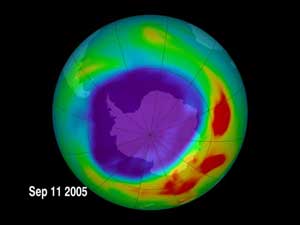Scientists have recently reported that the ozone hole protecting the Earth will not self-repair as expected in the next two decades.
 |
|
Image of the ozone layer from September 2005. The purple area indicates low ozone levels above the Antarctic region (Source: Nasa) |
The Earth’s ozone layer protects us from 90% of the sun’s ultraviolet radiation, enabling life to exist on the surface of our planet. For many decades, the ozone layer has been weakened by chlorine and bromine gases in the atmosphere—resulting from industrial emissions created by humans. The ozone hole has formed over the Southern Hemisphere.
In recent years, scientists have attempted to limit the expansion of this hole using chemical methods, bringing hope that the ozone layer will eventually recover.
Modern electronic devices have predicted that the hole will disappear by 2050.
However, a new improved device developed by scientists at NASA and the National Oceanic and Atmospheric Administration recently forecast that this recovery will not happen before 2068. With this new device, data on clean materials used for artificial satellites and aircraft will be re-examined to determine if they have indeed contributed to the regeneration of ozone in the stratosphere above Antarctica over the past 27 years.
The ozone hole is not only found over Antarctica as we often assume; it is also much larger in areas of the atmosphere that have lower ozone levels compared to normal natural conditions.
The head of the recent study, Paul Newman, a scientist at NASA’s Goddard Space Flight Center, explained: “Above the surface in areas farther from the poles, such as in Africa or the U.S., ozone levels are only 3-6% lower than natural levels. Above Antarctica, ozone levels are reduced by more than 70% in the spring. This new research method allows us to better assess the decline of ozone gases above Antarctica and how we can reduce the time it takes to shrink the ozone hole.“
Additionally, Newman and his colleagues found that the ozone hole will not begin to shrink as previously thought. They indicated that this would not be possible until at least 2018, after which the ozone layer would begin to recover and would start to restore more rapidly. The new study also reaffirms the work that Newman and his team conducted last year, suggesting that the ozone hole will not be able to recover before 2065.


















































